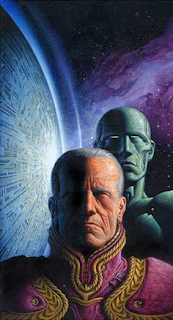 |
| brain variants (source) |
Why guilt? The fundamental source of my guilt is that I'm a picky science fiction reader. For example, I don't enjoy the insertion of horror elements into science fiction. Also, I am bored by real world politics and bored to tears by science fiction stories that expect me to read page after page of invented fictional politics. I'm thankful that one of my favorite science fiction authors, Isaac Asimov, rarely included horror in his stories. He tried to depict a world consumed by terror in his story Nightfall, but I could never take seriously the idea that a civilization would collapse because it suddenly got dark.
Asimov and Politics
 |
| interior art by Paul Orban |
1. Asimov wrote a couple of stories ("Evidence" and "The Evitable Conflict") about Stephen Byerley, a robot who became involved in politics. These stories could be called "The End of Politics" because they depict how the rational calculations of machines could replace human politicians.
 |
| cover art by Oscar Chichoni |
3. When he was nearing the end of constructing his Foundation Saga (in Forward the Foundation), Asimov explored an odd plot twist in which Hari Seldon was forced to become a politician. With Trantor crumbling around him, Seldon had to find a way to survive long enough to establish the First Foundation on Terminus and the Second Foundation on Trantor. Seldon was able to go toe-to-toe with the military junta that took control of Trantor and he helped Daneel guide Humanity into the Foundation Era.
I prefer fictional universes in which there is no mention of politics, but Asimov managed to bend his fictional politics to the needs of an interesting science fiction story. In the case of Asimov's fictional universe of robots and the Foundation, Daneel was secretly at work behind the scenes guiding Humanity towards the creation of Galaxia.
Politics of the tryp'At
 |
| original art work by Virgil Finlay |
Some readers of the Foundation Saga felt that Asimov made a mistake when he depicted Daneel as a kind of benevolent dictator who had created and controlled the Foundation. In the Exode Trilogy, I face the same problem with R. Gohrlay, who I reveal to be the meta-puppet master that controls Daneel. The remaining question is this: are the tryp'At Overseers also puppets of R. Gohrlay? Does it matter?
Why should we care?
 |
| cover art by Jim Burns |
In Isaac's Universe these six different species are biologically quite distinct. In addition to we humans, there is a species that is similar to Earthly porpoises. Aquatic alien species have long been popular in science fiction. In the Exode Trilogy, the Nereids play a major role, but rather than transition from aquatic life to life on land, the Nereids originated on land and then engineered themselves to be able to exist in an ocean environment.
 |
| cover art by Martin Andrews (click image to enlarge) |
In the Exode Trilogy, there are two species that can fly...sort of. One of these is the legendary Retair species. Their juveniles had vestigial wings that allowed them to fly in micro-gravity.
 |
| Michael Whelan cover art |
 |
| Michael Embden cover art |
Science fiction authors have always struggled with how to depict alien species. One approach is to simply make humanoid versions of various Earthly species such as cats or insects.
 |
| Martin Andrews cover art |
Martin H. Greenberg apparently wanted a fictional universe that was ready-made for politics. For Isaac's Universe, a group of competing species needed to be similar in the sense that they were each spreading their culture through the galaxy and colonizing exoplanets. I find it interesting that Asimov was not interested in writing stories set in "Isaac's Universe". I suspect he had no stomach for the imaginary intricacies of alien politics.
Here is how Asimov described the political terrain of Isaac's Universe:
 |
| insectoid cover art by Martin Andrews (click to enlarge) |
Life not as we know it
Just how different from we humans could biological organisms be? NASA has spent decades trying to "follow the water" in its search for life in our Solar System. However, the discovery of methane oceans revived the question: could there be forms of life that do not depend on liquid water?
 |
| Imaginary "methane bear" in a methane ocean |
 |
| Imaginary silicone life form (Horta) |
Too Human?
 |
| Map of the Sedronite species |
The green blob in the diagram to the left is my attempt to define a boundary that includes those Sedronites who we should think of as being part of the human family. It may be that only the "run-of-the-mill" humans who make up the bulk of the current human population of Earth and a few tryp'At are "human enough" to be allowed on Earth at this time.
 |
| tryp'At Overseers |
Not only do I now find myself having to investigate the political motives of the tryp'At, but I fear that I am "on the wrong side" in that I'm apparently playing out my role as an agent of the tryp'At. My remaining hope is that the tryp'At have seen into the future and they know that their efforts to remove non-humans from Earth will have beneficial effects. My fear is that I'll be tricked into doing something that will have disastrous consequences for our world. Will the Exode Trilogy turn out to be a horror story after all?
Next: the Hugos
 |
| visit the Gallery of Book and Magazine Covers |

No comments:
Post a Comment